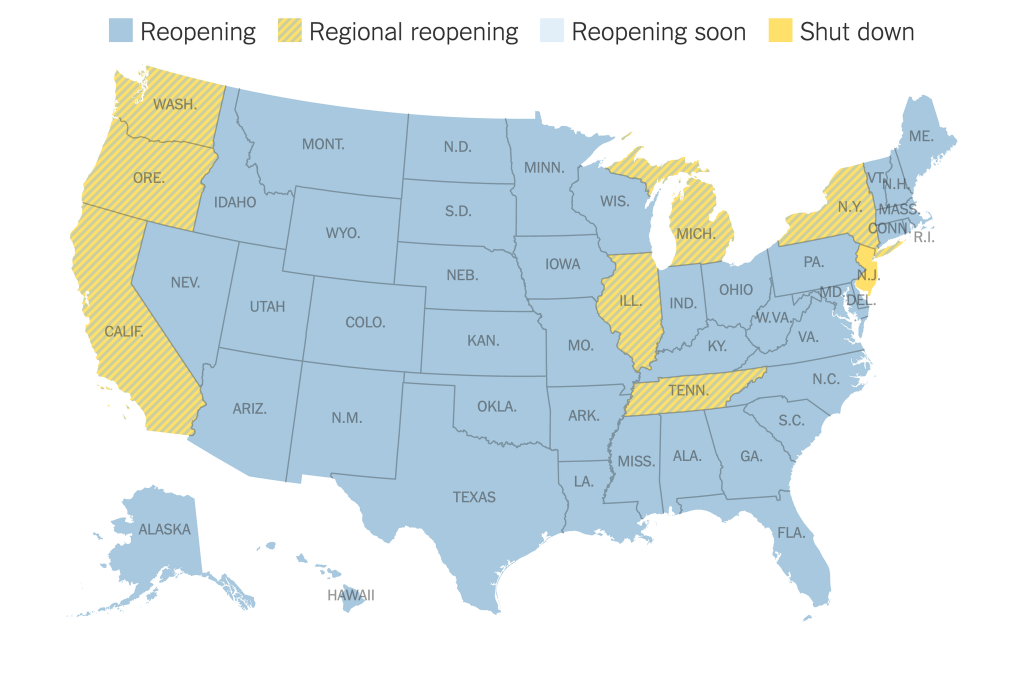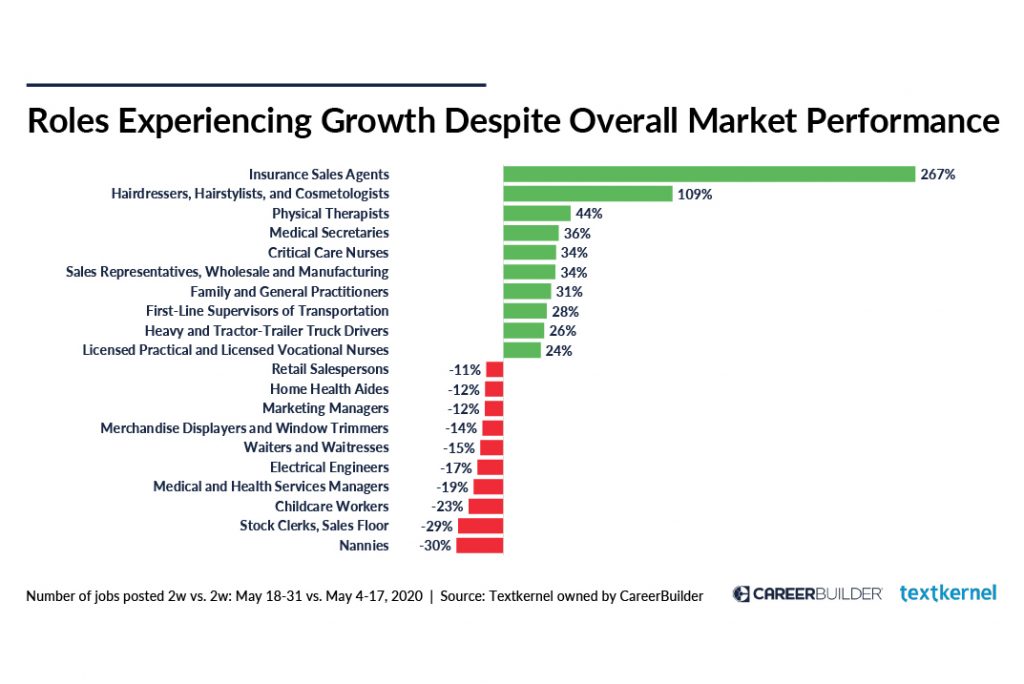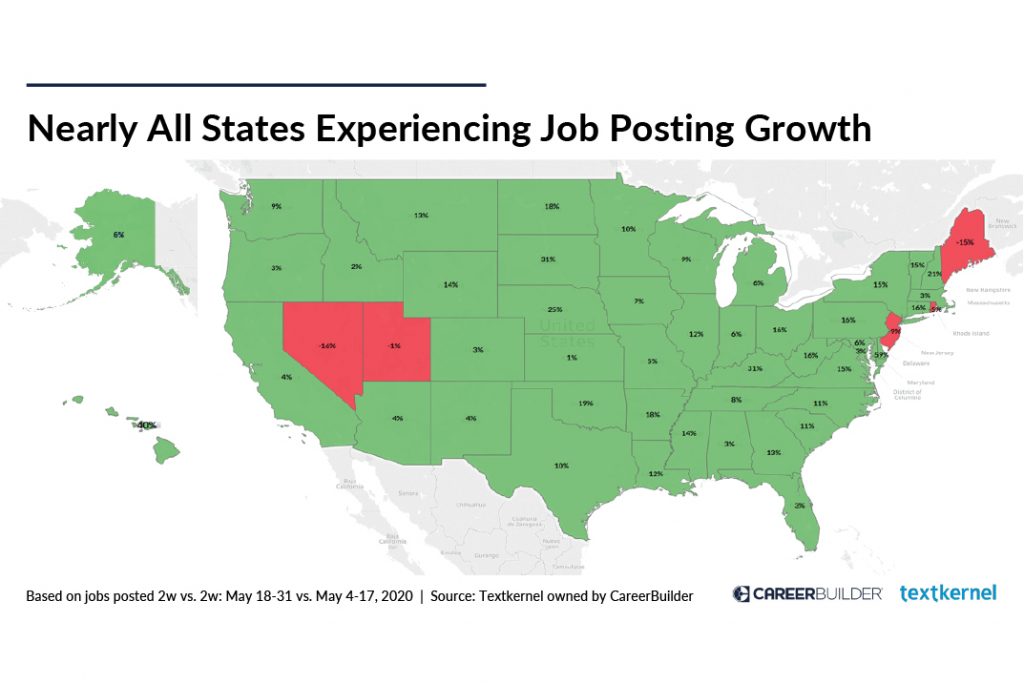Overview of Re-openings (by region)
Northeast
The northeast was certainly hit the hardest by the Coronavirus, however, a majority of the states have begun to reopen businesses again. States such as Rhode Island and Vermont are well into phase 2 of opening while states like New Jersey and New York are still only in their first phase.
South
The states in the south were hit second to worst; a large factor was from residents of the northeast traveling to their areas. Southern state Governors have not been coordinating with one another as a whole with re-openings. The only states to work together include Florida, Georgia, South Carolina, Tennessee, Alabama, and Mississippi. Southern states were actually the largest part of the grouping of states that were first to open up.
Midwest
The midwest experienced the least impact from the Coronavirus pandemic. All active stay-at-home recommendations have been lifted all across the midwest and dine-in is allowed in restaurants.
West
California, Oregon and Washington have agreed to synchronize together to figure out how and when they will begin lifting their shelter-in-place recommendations. Almost all of the active stay-at-home recommendations have been lifted; except for California and parts of Oregon.

Unemployment Stats
Unexpectedly, there were about 2.5 million jobs added to the economy in May as employers began rehiring laid-off workers.
According to an analysis of the labor department put together by Morgan Stanley, about 9.3 million workers lost jobs in April then 13.1 million went back to work in May.
The unemployment rate fell to 13.3% in May from 14.7% in April.
Overall hiring of new employees is still down. For example, job postings on Glassdoor fell about 5% in May. The 5% decrease in job postings followed a 30% decrease in postings in April from early March.
Some economists say job gains could resume this month.
The Bureau of Labor Statistics reported that 20,935,000 Americans were unemployed in the month of May. Also in May, employers added 2,509,000 to the economy due to states re-opening. It was also reported by the Bureau of Labor Statistics that the week of May 11th to May 16th 29,965,415 Americans received unemployment insurance benefits.
The Becker Friedman Institute shared that they estimate that 42% of individuals that were furloughed will not be getting their old jobs back and that 30% of the individuals that were laid off will find new jobs later in the year.
When learning about these numbers it is important to recognize that most numbers are estimates and can vary because every institution gathers information differently. In times of unplanned events, like the Coronavirus pandemic, inaccurate information can be produced by computers that do not think unplanned events occur. For example, the system created by the Bureau of Labor Statistics can have a glitch in their model and not be receptive to disruptions like the impacts of COVID-19. In addition, when calculating unemployment rates and numbers can also not be completely accurate because there is a large amount of “missing workers” that are not calculated into the number. “Missing workers” are individuals that do have the potential to work, but are not actively seeking work because of low job opportunities. The individuals that are counted into unemployment rates are those who are actively seeking work.
What Industries are Hiring
Restaurants and bars
Job postings in May on Glassdoor went up 6% for restaurants and bars.
Beauty and fitness
Online job postings were up about 3% for beauty and fitness jobs.
Travel and tourism
There was a 7% increase in job postings for travel and tourism for the month of May.
Private security services
In May, there were 8% more job postings for private security services online.
Grocery
Essential businesses like grocery stores found that they needed to add more employees to their staff. From early March to mid-May online job postings increased more than seven times for grocery managers and increased 177% for the workers who package goods for deliveries.
Warehouse
Since so many businesses have added e-commerce to their business plans, the need for warehouse managers have gone up significantly. From the beginning of March to the middle of May, job postings went up 145% for warehouse managers and 89% for customer service sales representatives.
Public health advisers
Job postings for public health advisers went up 59%
Banking
Bank hiring has increased greatly as more mortgage refinancing and employees are needed to handle the demand for the government’s small-business loan program. Hiring in banking and finance have increased 25% compared to pre-crisis levels.
Technology specialists
Job postings for technology specialists had increased about a third.
Other Industries/Job positions to keep an eye out for
- Tech workers
- Accountants
- Lawyers
- Creative directors
- Therapy
- Underwriting
- Mortgage and real estate
- Banking
- Gaming
- System administration
- Mental health
- Call center
- Database administration
- K-12 education
- Outbound calls
- Inbound calls
- Translation
- Accounting and finance
- Online teaching
The demand for these job positions has risen because they are most likely in industries that are either stable or growing. Industries such as e-commerce, health care, financial services and insurance have seen a growth in demand for new employees.



